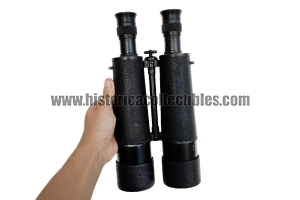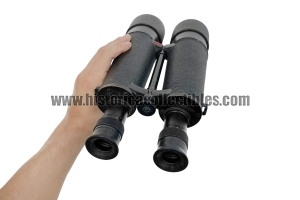Dienstglas Goerz DF 7x52,5 per "Scheinwerfereinheiten" (Headlights Units), 1918
Dienstglas mod. DF 7x52.5 produced by Goerz in 1918, to be used for the "Scheinwerfereinheiten" (Headlights Units) stations. This binoculars, equipped with Abbe-König roof prisms, are mentioned in the Wehrmacht service regulations "H.Dv. 448/1" of 1927 and are still mentioned in those published in 1940.
Its production also ranged between 1918 and 1926, the year in which it was replaced, thanks to the merger between Goerz and Zeiss, by the Zeiss mod. DF 7x50.
On the left eyepiece plate there is the Goerz logo, while on the right plate the technical information of the binoculars is shown: DF (Doppelfernrohr) and 7x52.5, where 7 are the magnifications and 52.5 the diameter of the objective lenses, a characteristic which makes the view very bright indeed. Furthermore, "Dienstglas" is present and still legible, having survived an attempted abrasion in an unknown period, which claims to be an assignment to a military corps.
The serial number is shown on the front bridge and places it as manufactured in 1918.
In addition to its use in the "Scheinwerfereinheiten" stations, the regulation also provided for its use with a tripod but there are, to date, no such complete specimens.
It was made in 2 versions: the 7x and the 10x and its civilian variant was called "Perpax".
The binoculars are in excellent condition and in good working order.
The C.P. Goerz was a company of optical and photographic instruments founded in Berlin in 1886 by Carl Paul Goerz (1854-1923), together with Carl Moser, optical researcher, and Ottomar Anschutz, laboratory technician in close friendships; precisely from this last C.P. In 1889, Goerz had purchased the patent for the construction of the first shutter for cameras capable of shutter speeds of 1/1000 of a second. The company specialized in the production of lenses, cameras, telescopes and binoculars, including for military use.
In 1886 it had around 25 employees, which rose to 2500 in 1911, although at its maximum expansion the workforce reached 10,000 employees. In terms of size it was not even second to Zeiss (which in the same period had 1000 fewer workers), and it exported to many countries, including Russia and the United States.
In 1905 Goerz American Optical continued to operate independently in the United States until 1972.
In 1908 Goerz Photochemisches Werk GmbH was founded in Berlin, this section of the Goerz group produced films for photography and cinema.
Goerz had a fundamental relationship with the armies of the time and military supplies. In fact, it remained famous both for the large trench binoculars (First World War) and for the binoculars supplied to all the weapons of the Austrian-German Army (including navy and air force) as well as Bulgaria, Romania etc.
Even today there are countless examples of Goerz binoculars that have value on the war and optical antiques market, one must think that in 1906 Goerz had already produced and exceeded 100,000 "Triëder" model binoculars, both for civil and military use. In addition to the main and historic factory in Friedenau (Berlin), C.P. Goerz was also present in London, Paris and Vienna, Bratislava, Milan, Riga and St. Petersburg.
Other sections were dedicated to chemical products and also for typewriters or calculating machines, which a division of the company was responsible for producing until 1945.
In 1910 the company bought the "Sendlinger Optische Galswerke" company founded by J. Von Fraunhofer and C. A. Steinheil for the production of optical glass and mirrors, which made it completely independent from purchasing from other retailers.
After the First World War, with the Treaty of Versailles, the German companies that had produced war material were slowed down in production and this quickly led to a serious economic situation.
In 1923 Paul Goerz died and the company, which was in bankruptcy, was purchased by Zeiss which, together with the companies "Contessa", "Nettel", "ICA" and "Ernemann" founded Zeiss Ikon in 1926. The American division of Goertz became an independent company under the name Goertz American Optical Co. producing camera lenses and continuing their technical development.
In 1971 it was bought by Kollmorgen, which was absorbed by Schneider Optics in 1972.



